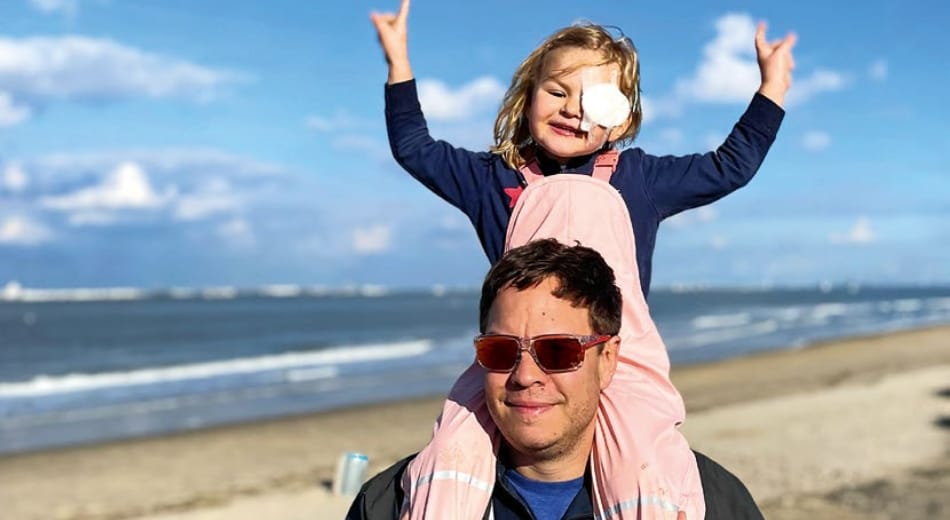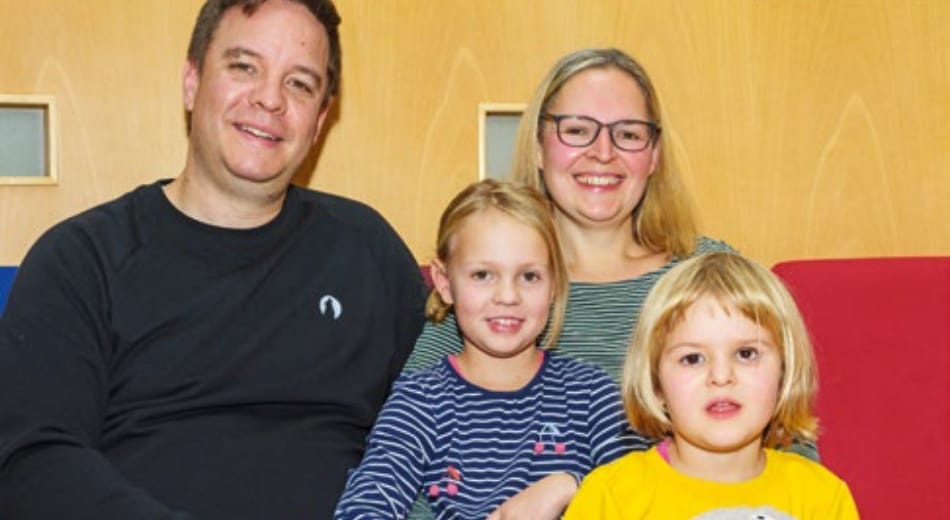Unique stories
Four-year-old Nora and her “magic eye”

Four-year-old Nora has several of her “magic eyes” – and if you don’t know that her left eye is a glass eye, you won’t notice it (at first). Nora makes no secret of the fact that she can only see out of one eye: in the kindergarten at the Tannheim aftercare clinic, Nora willingly shows the children her glass “magic eye”.
Her left eye had to be removed after she was diagnosed with eye cancer in the fall of 2021, by which time she had already been almost blind for months and the world had become two-dimensional for the little girl: Nora has to relearn how to judge distances, heights and depths with her one healthy eye.
Aftercare treatment in Tannheim is the first step into this “other world of sight”. Her cuddly toy, the elephant named “ELLI”, is always with her.
He is a gift from the “KinderAugenKrebsStiftung” (Children’s Eye Cancer Foundation) and, like the children themselves, has a removable eye.
Elli is a companion, ally and comforter for these children who have been severely affected.
“The left eye reflected the sun differently than the right,” says the mother during a conversation at the end of the family-oriented rehab in Tannheim, describing her suspicion in summer 2021 that her daughter Nora might have serious eye problems.
A check-up confirms the suspicion – now parents Britta and Kai Wagner have to wait eleven weeks for an urgent appointment with an ophthalmologist… During this time, Nora increasingly complains of headaches and seems “clumsy”.
Looking back, mother Britta suspects: “That was the time when the retina began to detach and Nora could no longer see anything.”
When the ophthalmologist’s appointment can finally be attended, it is revealed that Nora has gone blind in her left eye and she is immediately admitted to the Winterberg Clinic in Saarbrücken.
There was no hesitation and Nora was referred to the Department of Ophthalmology at Essen University Hospital.
After a short time, the suspicion that had already arisen during the examination by the ophthalmologist and at the hospital in Saarbrücken was confirmed: Nora is suffering from an early childhood cancer, the rare retinoblastoma – commonly known as “eye cancer”.
Nora is in the right place at the University Medical Center in Essen: the university hospital is a leader in therapy and research into this eye cancer.
There are around 60 new cases per year in Germany and most of these children are treated in Essen.
An interdisciplinary team of pediatric oncologists, ophthalmologists, neuroradiologists, human geneticists, pathologists and radiotherapists look after the sick children.
There is hope: advances in diagnostics and surgical techniques mean that today more than 95 percent of children with the disease survive.
Father Kai Wagner: “It was a real shock for us, the MRI scans showed that the tumor had already taken up two thirds of the eyeball. There was no chance of saving the eye. If it had been preserved for cosmetic reasons, the second eye could also have been affected by the cancer. So it was clear that we would decide to remove the eye.”
Mother Britta adds: “There was really no chance of saving the eye, whether through chemotherapy, radiation, laser or other methods.”
Only 14 days until the operation
The operation took place on October 12, 2021, with just 14 days elapsing between the initial diagnosis and the removal of the eye.
But how do you prepare a four-year-old child like Nora for such an operation?
The parents: “She herself had already noticed that something was wrong and that the eye was no longer working properly. We explained to her that the eye was broken and that we had to see if it could be repaired.
But if it can’t be repaired, the eye is dangerous for her, could make her ill and must be removed.
And that she will get a magic eye made of glass as a replacement.” The parents add that both the information and the preparation for the operation in Essen were simply great.
Nora’s eight-year-old sister Ida-Marie also received loving care.
After the operation, Nora wants to leave the hospital as quickly as possible as she is under enormous nervous strain.
As the operation takes place during coronavirus times, only her mother is allowed to accompany her daughter.
Her father and sister Ida-Marie spend the night in the foundation house next to the clinic.
Because her daughter wants to go home, her mother Britta and Nora are already on the intercity train two days after the operation.
“As soon as Nora arrived home, she ate a huge portion, relaxed and was simply happy,” says her mother, looking back.
“Glass eye” is a large contact lens
Nora felt fit – and on the Saturday after the operation, the family went on vacation to Holland.
The Wagners are following the doctors’ recommendation.
For Nora herself, the first few days after the operation are more of a relief than a burden.
She no longer complains of headaches and five days after the operation she is whizzing along the beach with her friends… However, it is difficult to assess the highs and lows.
It takes time to learn, for example, to recognize from the shadows of objects what danger they could pose.
Three and a half weeks after the operation, the healing process is so far advanced that Nora is fitted with her “magic eye”.
This is no longer a crystal ball, as we know it from pirate movies, for example.
After the eye is removed, a sphere with a rough surface is inserted into the eye socket.
It also has the task of encouraging the bones around it to continue growing.
However, “only” the visual muscles are connected to this sphere, so it moves.
The actual transparent eye, which resembles a large contact lens, is only placed on the conjunctiva of the eye once it has been sutured. This “magic eye” moves along with the child’s gaze thanks to the plastic ball connected to the muscles in her eyes, but is not recognizable as an artificial eye to the unbiased observer.
Nora can blink and even tears flow from her “magic eye”.
And she gets a new prosthesis with every new shoe size – her artificial eye grows with her, so to speak.

Britta and Kai Wagner with their daughters Ida-Marie (8) and Nora (4) during rehab in Tannheim.
Daughter Nora is learning to find her way around our three-dimensional world better after her eye cancer operation and to better assess ups and downs with her remaining healthy eye.
Enthusiastic about the aftercare in Tannheim
The recommendation to go into family-oriented rehab was made by the social services department at Essen Hospital immediately after the operation.
As they had only heard good things about Tannheim, the Wagner family opted for this facility and were delighted from the very first hour.
The aftercare clinic is well organized and offers super treatment.
In view of Nora’s medical history, the parents attach particular importance to the opinion of experts.
They want to hear from them how ergo- and physiotherapeutic care can help Nora to compensate for her eye loss.
The family also wants to find some peace and quiet.
The result of the four-week rehabilitation program is extremely positive: the occupational, physiotherapy and riding therapy that Nora undergoes in Tannheim gives her significantly more motor skills.
Her mother Britta: “She no longer falls so often when running – she climbs up somewhere completely differently. Tannheim has helped her a lot! Nora is full of confidence and vitality.”
The parents also benefit: Physiotherapy, massage and yoga help Britta Wagner to reduce the inner tension resulting from her anxiety about her child.
Kai Wagner can recharge his batteries with physiotherapy and lots of sport and minimize the inner pressure.
The discussions with the head oncologist Dr. Weis are important.
The prognosis for Nora’s future health can be discussed with him in peace and quiet.
Conclusion of the Wagner family: “Tannheim is warm and welcoming, offers the best possible individual relaxation. And you can just talk things off your chest over a beer in the evening. Especially nice: Nora’s sister Ida-Marie also felt completely at ease.”

Source: “Dankeschön” magazine 01/2023 – German Childhood Cancer Aftercare Foundation
Author: Wilfried Dold, doldmedia